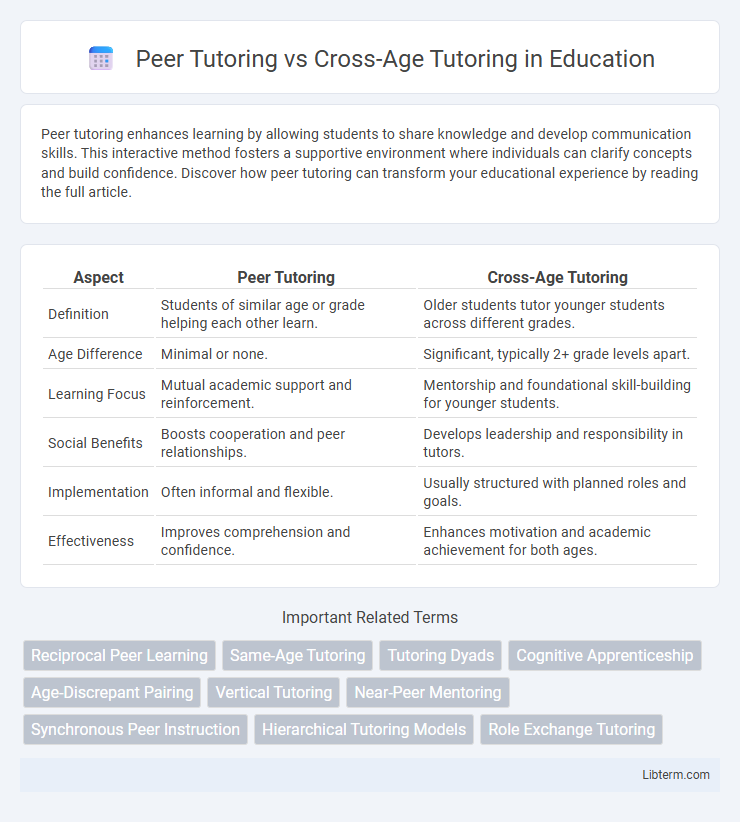Peer tutoring enhances learning by allowing students to share knowledge and develop communication skills. This interactive method fosters a supportive environment where individuals can clarify concepts and build confidence. Discover how peer tutoring can transform your educational experience by reading the full article.
Table of Comparison
| Aspect | Peer Tutoring | Cross-Age Tutoring |
|---|---|---|
| Definition | Students of similar age or grade helping each other learn. | Older students tutor younger students across different grades. |
| Age Difference | Minimal or none. | Significant, typically 2+ grade levels apart. |
| Learning Focus | Mutual academic support and reinforcement. | Mentorship and foundational skill-building for younger students. |
| Social Benefits | Boosts cooperation and peer relationships. | Develops leadership and responsibility in tutors. |
| Implementation | Often informal and flexible. | Usually structured with planned roles and goals. |
| Effectiveness | Improves comprehension and confidence. | Enhances motivation and academic achievement for both ages. |
Introduction to Peer Tutoring and Cross-Age Tutoring
Peer tutoring involves students of similar age or grade levels helping each other to improve academic performance and foster collaborative learning. Cross-age tutoring pairs older students with younger peers, promoting leadership skills and providing tailored support to novice learners. Both methods enhance understanding, engagement, and confidence by leveraging peer relationships within educational settings.
Defining Peer Tutoring: Concepts and Applications
Peer tutoring involves learners of similar age or skill level engaging collaboratively to enhance academic understanding and social skills. This instructional approach leverages reciprocal interactions where both tutor and tutee benefit from knowledge exchange and problem-solving activities. Applications of peer tutoring span diverse educational settings, promoting active learning, increased motivation, and personalized support within classrooms.
Understanding Cross-Age Tutoring: Key Characteristics
Cross-age tutoring involves older students mentoring younger peers, fostering leadership skills and reinforcing academic content for both tutor and tutee. Key characteristics include developmental gap as a core aspect, where older tutors adapt teaching methods to suit the younger learners' cognitive levels and social-emotional needs. This approach enhances personalized learning, promotes positive role modeling, and encourages confidence-building through reciprocal interaction.
Educational Benefits of Peer Tutoring
Peer tutoring enhances student learning by promoting active engagement and reinforcing subject knowledge through reciprocal teaching interactions. It fosters critical thinking, improves communication skills, and encourages collaborative problem-solving among peers at similar developmental levels. Studies indicate peer tutoring boosts academic achievement and self-confidence more effectively compared to cross-age tutoring, due to the relatability and mutual understanding shared between peers.
Unique Advantages of Cross-Age Tutoring
Cross-age tutoring fosters leadership skills and boosts self-esteem in older students by positioning them as mentors to younger peers, creating a positive role model effect. It enhances cognitive development and social-emotional learning through peer interaction across age groups, promoting empathy and responsibility. This approach often results in higher engagement and personalized support for younger students, improving academic outcomes and confidence.
Comparing Learning Outcomes: Peer vs Cross-Age Tutoring
Peer tutoring, where students of similar age and academic ability engage in mutual learning, often enhances understanding and retention through collaborative problem-solving, leading to improved academic performance especially in subjects like math and reading. Cross-age tutoring involves older students instructing younger peers, which not only solidifies the tutor's knowledge but also boosts the tutee's confidence and motivation, resulting in positive impacts on social skills and self-esteem. Comparative studies indicate peer tutoring typically yields stronger gains in academic achievement, while cross-age tutoring excels in fostering interpersonal development and long-term engagement with learning.
Social and Emotional Impacts on Students
Peer tutoring involves students of similar age collaborating, which fosters mutual empathy, enhances communication skills, and builds a supportive learning environment that boosts self-esteem and emotional resilience. Cross-age tutoring pairs older students with younger peers, promoting leadership, responsibility, and positive role modeling, which significantly improves social skills and reduces anxiety in both groups. Studies show these tutoring formats contribute to improved social competence and emotional well-being, with cross-age tutoring often resulting in enhanced mentorship experiences and sustained confidence growth.
Implementation Challenges and Solutions
Peer tutoring often faces implementation challenges such as matching students effectively and ensuring consistent training, which can be mitigated through structured pairing algorithms and ongoing tutor workshops. Cross-age tutoring encounters difficulties like managing age-related power dynamics and scheduling conflicts, resolved by clear role definitions and flexible session timings. Leveraging digital platforms streamlines coordination and enhances communication, improving the overall success of both tutoring models.
Best Practices for Successful Tutoring Programs
Peer tutoring involves students of similar age and grade supporting each other's learning, while cross-age tutoring pairs older students with younger ones to enhance mentorship and academic skills. Best practices for successful tutoring programs include clear role definitions, targeted training for tutors on communication and content knowledge, and structured feedback mechanisms to monitor progress and program effectiveness. Incorporating evidence-based strategies like matching tutors and tutees based on learning styles and providing consistent scheduling improves engagement and academic outcomes.
Selecting the Right Tutoring Approach for Your Classroom
Selecting the right tutoring approach depends on specific classroom goals and student needs, with peer tutoring involving same-age students collaborating to reinforce learning and cross-age tutoring pairing older students as mentors to younger peers for guided academic support. Peer tutoring fosters mutual understanding and relatable communication, ideal for promoting cooperative learning and social skills among similar developmental stages. Cross-age tutoring leverages the leadership and advanced knowledge of older students, enhancing confidence and providing role models while addressing varied skill levels across age groups.
Peer Tutoring Infographic

 libterm.com
libterm.com